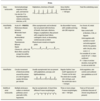CARDIOVASCULAR USMLE Flashcards
Causas de bradicardia
physical fitness, sick sinus syndrome, drugs, vasovagal attacks, acute MI, ↑ intracranial pressure.
Causas de taquicardia
nxiety, anemia, pain, fever, sepsis, CHF, PE, hypovolemia, thyrotoxicosis, CO2 retention, and sympathomimetics.
Causas de desviacion eje derecha y eje izquierda
TIP: Eje II, III, aVF
RAD RALPH, the LAD from VILLA hates WOLVES
Right Axis Deviation
Right ventricular hypertrophy
Anterolateral MI
Left Posterior Hemiblock
(also consider PE)
Left Axis Deviation
Ventricular tachycardia
Inferior myocardial infarction
Left ventricular hypertrophy
Left Anterior hemiblock
WOLVES – Wolf-Parkinson-White syndrome can cause BOTH

Imagen del bloqueo de rama
Left bundle branch block—
WiLLiaM
V1 = W QRS pattern
V6 = M QRS pattern
Right bundle branch block—
MaRRoW
V1 = M QRS pattern
V6 = W QRS pattern

Cambios ECG IAM
- Horas: peaked T-waves and ST-segment changes (either depression or elevation)
- 24 horas: T-wave inversion and ST-segment resolution
- Algunos dias: pathologic Q waves (> 40 msec or more than onethird of the QRS amplitude). Q waves usually persist, but may resolve in 10% of patients. Because of this, Q waves signify either acute or prior ischemic events.
- In a normal ECG, R waves increase in size compared to the S wave between leads V1 and V5. Poor R-wave progression refers to diminished R waves in these precordial leads, and can be a sign of infarction, although it is not specific.
Taquicardia atrial: Causas . Etiologia . Imagen

Taquicardia union auriculoventricular

Taquicardia ventricular

Manejo crónico de ICC
Chronic:
Lifestyle: Control comorbid conditions, and limit dietary sodium and fluid intake.
Pharmacologic therapy:
- β-blockers and ACEIs/ARBs: Help prevent remodeling of the heart and ↓ mortality for NYHA class II–IV patients. Avoid CCBs (can worsen edema).
- Low-dose spironolactone: Shown to ↓ mortality risk in patients with NYHA class III–IV heart failure.
- Diuretics (most commonly loop diuretics): Prevent volume overload.
- Digoxin: Symptomatic control of dyspnea and ↓ frequency of hospitalizations.
- Daily ASA and a statin are recommended if the underlying cause is a prior MI.
Advanced pharmacologic therapy:
- Sacubitril/valsartan: angiotensin receptor-neprilysin inhibitor (ARNI) is a new drug class used in patients who continue to be dyspneic despite using the initial pharmacologic regimen. Provides mortality benefit for systolic dysfunction.
- Ivabradine: Reduces heart rate through SA nodal inhibition of the “funny channels.” Indicated in patients with systolic dysfunction if pulse is > 70 bpm or β-blockers are contraindicated.
Advanced treatments:
- Implantable cardiac defibrillator (ICD) in patients with an EF < 35%. Shown to ↓ mortality risk.
- Biventricular pacemaker in patient with an EF < 35%, dilated cardiomyopathy, and widened QRS complex with persistent symptoms.
- Left ventricular assist device (LVAD) or cardiac transplantation may be necessary in patients who are unresponsive
TIP: Diuretico y digoxina no disminuye la mortalidad de ICC solo mejoria sintomatica. CCB incrementan la mortalidad.


